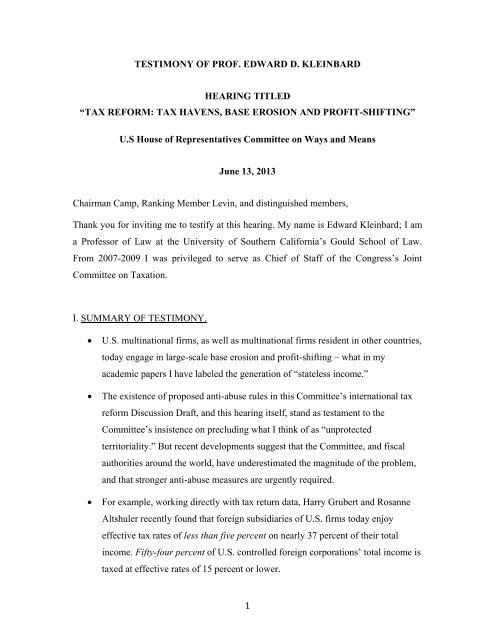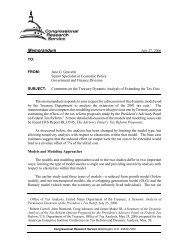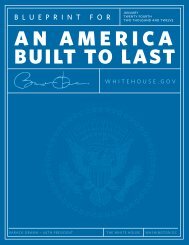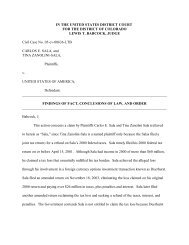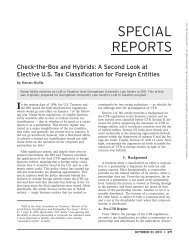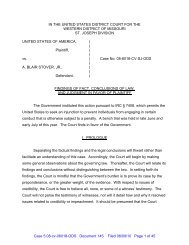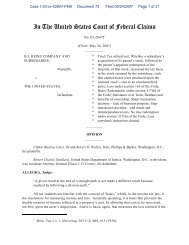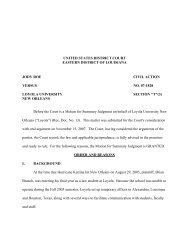1 TESTIMONY OF PROF. EDWARD D. KLEINBARD HEARING ...
1 TESTIMONY OF PROF. EDWARD D. KLEINBARD HEARING ...
1 TESTIMONY OF PROF. EDWARD D. KLEINBARD HEARING ...
- No tags were found...
You also want an ePaper? Increase the reach of your titles
YUMPU automatically turns print PDFs into web optimized ePapers that Google loves.
<strong>TESTIMONY</strong> <strong>OF</strong> PR<strong>OF</strong>. <strong>EDWARD</strong> D. <strong>KLEINBARD</strong><strong>HEARING</strong> TITLED“TAX REFORM: TAX HAVENS, BASE EROSION AND PR<strong>OF</strong>IT-SHIFTING”U.S House of Representatives Committee on Ways and MeansJune 13, 2013Chairman Camp, Ranking Member Levin, and distinguished members,Thank you for inviting me to testify at this hearing. My name is Edward Kleinbard; I ama Professor of Law at the University of Southern California‟s Gould School of Law.From 2007-2009 I was privileged to serve as Chief of Staff of the Congress‟s JointCommittee on Taxation.I. SUMMARY <strong>OF</strong> <strong>TESTIMONY</strong>.U.S. multinational firms, as well as multinational firms resident in other countries,today engage in large-scale base erosion and profit-shifting – what in myacademic papers I have labeled the generation of “stateless income.”The existence of proposed anti-abuse rules in this Committee‟s international taxreform Discussion Draft, and this hearing itself, stand as testament to theCommittee‟s insistence on precluding what I think of as “unprotectedterritoriality.” But recent developments suggest that the Committee, and fiscalauthorities around the world, have underestimated the magnitude of the problem,and that stronger anti-abuse measures are urgently required.For example, working directly with tax return data, Harry Grubert and RosanneAltshuler recently found that foreign subsidiaries of U.S. firms today enjoyeffective tax rates of less than five percent on nearly 37 percent of their totalincome. Fifty-four percent of U.S. controlled foreign corporations‟ total income istaxed at effective rates of 15 percent or lower.1
My own new paper looks at Starbucks Corporation, a classic bricks and mortarretail business model, with direct customer interactions in thousands of “highstreet” locations in high-tax countries around the world. Nonetheless, it appearsthat Starbucks has successfully reduced its foreign tax liabilities to surprisinglylow levels. To put matters bluntly, if Starbucks can organize itself as a successfulstateless income generator, any multinational firm can.The recent Senate PSI hearing focusing on Apple Inc. also is consistent with theseriousness of the situation. What was most remarkable was the baldness ofApple‟s tax planning. The entirety of the business arrangements that explain whyApple paid virtually no tax anywhere in the world on tens of billions of dollars ofincome attributable to U.S. R&D boils down to this: in 1980 Apple created a shellcompany subsidiary in Ireland, capitalized it, and entered into a special kind ofcontract with this shell company (a “cost sharing agreement”), in which the shellcompany returned to Apple some of the capital seeded to it by Apple, thereby firstpurportedly acquiring ownership in all of Apple‟s intangible assets outside theAmericas. This description is a bit simplified, but in essence, that is the entirety ofthe story.The Apple hearing, press articles and comments filed with this Committee inresponse to its Discussion Draft all represent a healthy and widely-shared interestin improving the current system, even if proposed solutions vary. But currentdebates often are marred by the injection into the arguments of some recurringmyths and misunderstandings. I wish to address three of these.Myth I: We Should Cheer When Our Companies Avoid Foreign Taxes. It isintuitively appealing to argue that when “our” multinationals employ statelessincome technologies to minimize their foreign tax liabilities, the outcome issomething we should cheer rather than criticize. But this is false. That apparentlyforeign income often in fact is U.S. income traveling incognito. The stream of taxfreeforeign income encourages U.S. firms to engage in tax arbitrage, by leavingall their global interest expense in the U.S. parent, where it erodes the domestictax base (by reducing wholly domestic taxable income). The prospect of stateless2
income distorts investment decisions, by offering U.S. firms the possibility ofsupersized returns (what I call “tax rents”) on foreign investments. And finally,promoting our national champions to avoid the tax systems of other countriesleads to the mirror image response from them, and a beggar-thy-neighbor race tothe bottom, where multinational firms are the winners and every taxingjurisdiction the loser.Myth II: Firms‟ Money is Trapped Abroad, to Our Great Detriment. U.S. firmstoday have nearly $2 trillion in offshore so-called “permanently reinvestedearnings.” Some of that $2 trillion is invested in real businesses around the world,but a large fraction is held in cash. It is intuitively appealing to argue that all ofthis “trapped” cash is lying fallow, as if it were buried in a backyard in Zug. Butagain this is false. The money in fact already is at work in the United States, in theform of loans to the U.S. government or U.S. businesses. What is more, as Iexplain in my detailed comments, firms like Apple have demonstrated how easy itis to engage in a virtual repatriation of offshore cash on a tax-free basis, and usethat virtual transaction to fund current stock buy-backs.Myth III: Everything That U.S. Firms Do is “Legal.” U.S. multinational firmshave not done anything remotely illegal in their stateless income planning. Butobservers then wrongly conclude that everything that U.S. firms have done in thisarea must therefore be “legal.” This is a meaningless phrase in this context. Everylarge U.S. firm is audited by the Internal Revenue Service on a continuous basis.Firms take tax return positions that they expect to be challenged, they establishaccounting reserves for uncertain tax positions, and they often settle tax disputes(most commonly at the administrative level) by paying additional tax. Thequestion is not whether a particular firm‟s stateless income planning is “legal,”but rather whether that planning is inappropriately aggressive. By beingaggressive, some large multinational firms achieve tax results that they would notobtain if the energies available to the two sides of the argument were more evenlymatched. This in turn has important repercussions for tax system design. It meansthat a complex and highly fact-driven international corporate tax system3
invariably will lead to lower tax revenues than might be expected under moreneutral terms of engagement, and it means that the corporate tax system in turnwill have a negative spillover into personal tax collections, through a degradationof individuals‟ confidence in the fairness of the tax system.What then should we do? There is something of a consensus around the idea of aterritorial system with anti-abuse constraints (or a “hybrid” system, as someprefer), but I respectfully submit that there is a far simpler alternative that is moreresistant to tax gaming, that is “competitive,” and that is economically defensible:genuine worldwide tax consolidation, combined with a corporate tax rate squarelyin the middle of the pack of peer countries‟ rates – say 25 percent. Financialaccounting norms of course require worldwide consolidation in presenting theresults of a multinational firm‟s activities. The resulting system is simple and,more important, highly resistant to tax gaming, because there are no positivereturns to base erosion or profit shifting. What is more, my proposed system is“competitive,” in proper sense of being competitive with the tax environment thatforeign domestic firms actually face in the country in which they operate, ratherthan a system that, like current law, or like unprotected territoriality, heavilysubsidizes foreign investment, at the expense of our own domestic economy. If ithelps, one can visualize my proposal as a territorial tax system with a 25 percentworldwide (not per country) minimum tax – the economic effects are the same.Finally, without regard to the fate of tax reform legislation, I urge the Committeeto work with other Committees of the House to put onto a fast track legislationrequiring every U.S. multinational firm to publish a worldwide disclosure matrixof its actual tax burdens by jurisdiction. Tax transparency rules are not a substitutefor substantive international tax reform, but they would enable tax authorities toidentify possible patterns of inappropriate income shifting, thereby making betteruse of limited audit resources. A transparency principle further would awaken thepublic to the massive amounts of international tax avoidance today known only tospecialists.4
II. THE PROBLEM IS REAL.I am fortunate to have spent 30 years in private practice, where my clients largelycomprised multinational firms, to have served at the Joint Committee on Taxation, wherewe worked on international tax law design and compliance issues, and now to work as anacademic, with the time and the freedom to do research on international tax law policyfrom both legal and economic perspectives. Drawing on my experience and research, Iam confident that U.S. multinational firms, as well as multinational firms resident inother countries, today engage in large-scale base erosion and profit-shifting – what in myacademic papers I have labeled the generation of “stateless income.” 1In 2011, this Committee published a “Discussion Draft” of a possible new U.S.international tax system applicable to foreign direct investment. For the reasonsdeveloped in this testimony I do not agree with every policy that the Discussion Draftendorses, but it is unquestionable that the Discussion Draft and accompanying materialsreflect a great deal of thoughtful work. In particular, I believe that the Committee shouldbe commended for acknowledging from the start that stateless income generation isinconsistent with the premises of any well-designed territorial tax system, and foroutlining some possible anti-abuse and thin capitalization rules that would addressaspects of the issue. 2 This hearing also stands as a testament to the Committee‟sdetermination to address the consequences of what I think of as “unprotectedterritoriality.” But recent developments suggest that the Committee, and fiscal authoritiesaround the world, have underestimated the magnitude of the problem, and that strongeranti-abuse measures are urgently required.1 Stateless Income, 11 Florida Tax Rev. 699 (2011); The Lessons of Stateless Income, 65 Tax LawRev. 99 (2011); Through a Latte, Darkly: Starbucks’ Stateless Income Planning (draft of May 28,2013 available at http://papers.ssrn.com/sol3/papers.cfm?abstract_id=2264384), forthcoming, TaxNotes.2 Edward Kleinbard, Three Cheers for Dave Camp, 138 Tax Notes 619 (Feb. 4, 2013).The Lessons of Stateless Income, 65 Tax Law Rev. 99 (2011), explores in detail how statelessincome technologies undermine the (usually unstated) premises of standard theoreticaljustifications of territorial tax systems.5
One way to drive home the point that firms are awash in stateless income is tolook at the most recent empirical work in this area, by Harry Grubert of the U.S. Treasuryand Rosanne Altshuler at Rutgers. 3 Working directly with tax return data, they found thatforeign subsidiaries of U.S. firms today enjoy effective tax rates of less than five percenton nearly 37 percent of their total income. Fifty-four percent of U.S. controlled foreigncorporations‟ total income is taxed at effective rates of 15 percent or less. As Dr. Gruberthas noted in another context, these low rates cannot be explained as the consequence ofhundreds of billions of dollars of investments in pubs in Ireland. What is more, these totalincome numbers include large petroleum companies and other natural resources firms,which generally are stuck with very high foreign tax rates that cannot be avoided, due tothe fixed location of those resources. If natural resources firms were excluded, theproportion of super low-taxed total income would increase.In classic academic style, Drs. Grubert and Altshuler buried the lede deep in theirpaper, but these hard data drawn from actual tax returns are irrebuttable proof of themagnitude of stateless income generation in the wild. Corroboration can be found infirms‟ financial statements 4 and, indirectly in their extraordinary hoards of offshore cash(and the rapid rise of those cash balances), now totaling nearly $2 trillion. 5It sometimes is argued that only high-tech and pharmaceutical firms takeadvantage of stateless income generation technologies, because they own high-valueintangibles that they can locate in a tax haven, and thereby direct royalties to thatintangibles ownership vehicle. It certainly is true that such firms are the beneficiaries ofextraordinarily low effective tax rates on their foreign income – often in the single digits– and that they rely heavily on artificial arrangements that purportedly transfer theownership of those intangibles to wholly-owned subsidiaries that conveniently claimresidence in very low-tax jurisdictions (or in the case of Apple, claim to be resident3 Harry Grubert and Rosanne Altshuler, Fixing the System: An Analysis of Alternative Proposalsfor the Reform of International Tax, draft of May 12, 2013 available athttp://papers.ssrn.com/sol3/papers.cfm?abstract_id=2245128.4 Stateless Income, 11 Florida Tax Rev. 699, 739 (2011) (Microsoft effective foreign tax rate of 4percent, and Google effective foreign tax rate of 2.4 percent).5 Wall St. J., CFO Journal, Indefinitely Reinvested Foreign Earnings on the Rise, May 7, 2013.6
nowhere at all – thereby extending the concept of stateless income to include statelesscompanies).The Senate‟s Permanent Subcommittee on Investigations (PSI) recently released acase study of Apple‟s stateless income generation strategies, which it used as backgroundinformation for its hearing on May 21 st on this topic. 6 It is useful to reflect on the lessonsof that hearing for a minute.What struck me as most remarkable about the PSI report and the hearing itselfwas the baldness of Apple‟s tax planning. It did not involve “Double Irish DutchSandwich” structures, exotic forms of Lichtenstein trusts or reliance on obscure taxtreaties. Instead, the entirety of the business arrangements that explain why Apple paidvirtually no tax anywhere in the world on $38 billion of income in the period 2009-11alone from research and development work conducted in California boils down to this: in1980 Apple created a shell company subsidiary in Ireland, capitalized it, and entered intoa special kind of contract with this shell company (a “cost sharing agreement”), in whichthe shell company returned to Apple some of the capital seeded to it by Apple, therebyfirst purportedly acquiring ownership in all of Apple‟s intangible assets outside theAmericas. This description is a bit simplified, but in essence, that is the entirety of thestory.I refer to Apple‟s Irish subsidiaries that purportedly own and exploit some of theworld‟s most valuable assets as “shell companies” because they are. Until 2012, the keyIrish subsidiary (Apple Sales International) had no employees and no independent abilityto act according to its own perceived interests. What little activity the shell companiesperformed ("negotiating" a cost sharing agreement with the parent company, where theshell companies act through the mouthpiece of senior Apple Inc. employees who were„dual hatted‟ to the Irish companies as well, and "negotiating" contracts with third partymanufacturers of Apple products, like Foxconn, when the record showed that thosecontracts again were in fact negotiated by Apple Inc. employees, and just mirror the6 Memorandum to the Members of the Permanent Subcommittee on Investigations Re: OffshoreProfit Shifting and the U.S Tax Code – Part 2 (Apple Inc.), May 21, 2013, available athttp://www.hsgac.senate.gov/subcommittees/investigations/hearings/offshore-profit-shifting-andthe-us-tax-code_-part-2.7
contracts used by Apple Inc.) were not in any way performed by actors independent ofApple Inc. Nor have the subsidiaries done anything with their crown jewel intangibleassets that is separate from what Apple Inc. does. These truly are shell companies.One issue that the Apple case study therefore presents is not where the "mindsand management" of the Irish shell companies might be, but whether they have anyminds at all? Do they really have the corporate mental capacity to enter into cost sharingagreements of such importance? If closely examined, would the cost sharing agreementhold up as a bona fide agreement entered into by two companies with their own resources,risk appetites and executives? Of course at some ultimate level this question is circular, inthat subsidiaries ultimately are controlled by parent companies, but in other cases withwhich I am familiar, extensive and expensive efforts were made to give substance and atleast the flavor of independence to the subsidiary.In watching the PSI hearing, I understood Apple's Chief Financial Officer toargue that, because the original cost sharing agreement was executed at the verybeginning of Apple Time (1980), it therefore cannot now be challenged as ineffective inproducing the tax magic ascribed to it. I respectfully suggest that in this he confused theenduring authority of his cost sharing agreement with the tablets brought down from themountain by Moses.Also during the hearing, Apple‟s Chief Executive Officer, Tim Cook, severaltimes made what I thought was an admission against tax interest, when he said that 95percent of Apple's collective creative genius was located in a single zip code in CupertinoCA. To the same effect, the PSI report found that less than one percent of Apple‟sworldwide research and development was conducted by its Irish subsidiaries, and that in2011, 95 percent of Apple‟s worldwide research and development was conducted inCalifornia. 7 As policymakers, it is appropriate for this Committee to ask whether costsharing agreements as coarsely constructed as this one seems to be really are efficaciousin shifting $74 billion in income over the four year period 2009-12 from this Cupertinocentriccreative genius to a stateless company.7 PSI Report p. 28.8
The Apple hearing generated a great deal of interest around the world. In manycases the lesson drawn from the hearing has taken the form of a general belief that theproblem lies with multinational high-tech and pharmaceutical firms. But it simply is notthe case that stateless income generation is their unique bailiwick. That is the point of mynew paper, Through a Latte, Darkly: Starbucks’ Stateless Income Planning. Starbucksfollows a classic bricks and mortar retail business model, with direct customerinteractions in thousands of “high street” locations in high-tax countries around the world.Moreover, Starbucks is not a firm driven by hugely valuable identifiable intangibles thatare separate from its business model, which it employs whenever it deals with those retailcustomers. Nonetheless, it appears that Starbucks enjoys a much lower effective tax rateon its non-U.S. income than would be predicted by looking at a weighted average of thetax rates in the countries in which it does business. To put matters bluntly, if Starbuckscan organize itself as a successful stateless income generator, any multinational firm can.III. MYTHS AND MISUNDERSTANDINGS.No one stands in defense of the current U.S. international tax system applicable toforeign direct investment. The Apple hearing, press articles and comments filed with thisCommittee in response to its Discussion Draft all represent a healthy and widely-sharedinterest in improving the current system, even if proposed solutions vary. But currentdebates often are marred by the injection into the arguments of some recurring myths andmisunderstandings. In the remainder of this section I address some of these.A. Myth I: We Should Cheer When Our Companies Avoid Foreign Taxes.It is intuitively appealing to argue that when “our” multinationals employ statelessincome technologies to minimize their foreign tax liabilities, the outcome is somethingwe should cheer rather than criticize. After all, lower foreign taxes means more netincome for “our” companies, and at least under current law, the highly theoreticalprospect of higher U.S. tax revenues when the money is fully repatriated (because therewill be smaller foreign tax credits to shelter the income).9
The argument is interesting for its implicit assumption that companies really dohave nationalities, and that we sometimes mentally equate “our” companies with, say,U.S. Olympic athletes in international competition. But the intuition that we should cheerwhen our corporate athletes minimize their foreign tax liabilities is false, for a number ofreasons.The first reason was one driven home by the Apple PSI hearing: what appearsfacially to be “foreign” income in fact often more properly should be classified as U.S.income in the first place. In cases like this, apparent foreign tax avoidance is in fact anextension of U.S. tax avoidance, and all Americans are the poorer for the missing taxrevenues.The second reason we should care about foreign tax avoidance in the service ofstateless income generation is that under current law streams of very low-taxed statelessincome enable U.S. firms to engage in tax arbitrage that erodes the U.S. domesticcorporate tax base. A U.S. firm has an incentive to capitalize its foreign subsidiaries withequity supplied by the parent company, to maximize the group‟s stateless income, and tooverleverage the U.S. parent company with third-party debt. By doing so firms candeduct their global interest expense against their U.S. domestic tax base. 8 The end resultis that it is not simply foreign tax revenues that have disappeared, but also U.S. taxrevenues on U.S. domestic income. In turn, the one rule that today purports to limit thisoverleveraging of the U.S. parent (by limiting foreign tax credits available to the U.S.parent) simply has no bite when foreign tax rates are driven to absurdly low levels.The third reason we should care about stateless income, even when it appears thatforeign countries, and not the United States, suffer the immediate tax revenue losses, is abit subtler. We live today in a globalized world of deep and liquid capital markets, andfew constraints on the cross-border movement of capital. Most economists begin theiranalyses of international tax policy from the premise that these conditions should meanthat risk-adjusted after-tax returns are roughly the same everywhere in the world. If this8 Stateless Income, 11 Florida Tax Rev. 699, 724-25, 757-58 (2011).10
were not true, investors would flock to the jurisdiction offering better returns for the samerisk, until the influx of new capital drove down those returns.In turn, this means that acceptable pretax returns must be higher in high-taxcountries, so that their after-tax returns reach the global level. This is the real cost ofhigher corporate taxes, for example: it is not that investors obtain lower after-tax returns,but rather that the pool of capital invested in such businesses is smaller, because someprojects that would be feasible in a lower tax rate environment do not achieve therequired global after-tax rate of return. Investors simply decline to make theseinvestments, rather than suffer lower returns.But stateless income planning undermines this neat story. If a U.S. firm can investin a high-tax foreign country, with its high pretax returns, and then avoid paying the taxthat is associated with returns in that country, the U.S. firm can generate supersizedreturns on its money – what I call “tax rents.” 9 For technical reasons, and the Apple Inc.story notwithstanding, it often is easier as a U.S. tax matter to shift profits from a hightaxforeign country to a low-tax one than it is to shift profits from the United States to atax haven. What this means is that, when the United States turns a blind eye to statelessincome planning, it inadvertently encourages U.S. firms to prefer foreign investment overU.S. investment – not investment directly in real businesses in low-tax jurisdictions (howmany Irish pubs are there to acquire?), but rather real businesses in high-tax foreignjurisdictions, to serve as the raw feedstock for the ultimate end product: super low-taxedincome, or in other words, tax rents.The final reason to object to U.S. firms‟ avid pursuit of stateless income isinternational comity. The United States is not just a capital exporter through foreigndirect investment; it also is a host country to inbound direct investment from foreignmultinational firms. It would be foolish to think that foreign multinationals do not playthe stateless income game, with the United States as host country as the tax revenue loser.Similarly, it is a fool‟s game to imagine that we can encourage “our” multinationals togame the tax systems of other countries, while successfully defending our borders from9 Stateless Income, 11 Florida Tax Rev. 699, 752-57 (2011). The Lessons of Stateless Income, 65Tax Law Rev. 99 (2011) considers in detail how stateless income undermines the globalequilibrium story that is the cornerstone of the policy case for a territorial tax system.11
the same sort of strategies. This is trade war by another name, in which the United Stateseffectively is subsidizing exports (in this case, of capital) and penalizing imports. Like alltrade wars, it will end badly, in a beggar-thy-neighbor race to the bottom, wheremultinational firms collectively will be the winners, and taxing jurisdictions the losers.The lesson is that international recognition of the importance of the statelessincome problem, and international consensus on solutions, are urgently required. This iswhy the OECD‟s report on base erosion and profit shifting was so important, and why theUnited States should vigorously push its peer countries in forums like the OECD and theG-8 to address the issue to recognize this for the global problem that it is. U.S. firms maybe the world leaders in tax avoidance technologies, but every multinational has learnedthe tricks of this business. The work of the OECD and other international institutionsshould not be allowed to degenerate into an unproductive bashing of U.S. firms as theunique locus of the problem.The OECD and other international forums also need to be mindful of the badhabits of policymakers worldwide to try to steal a march on other countries by arguingthat others should be bound to more rigorous standards, while they continue to subsidizethe international exploits of their national champions. Some countries (e.g. the UnitedKingdom) appear to me, as an outsider, to be of two minds on these issues: outraged thatas host countries they are the victims of stateless income revenue depredations, and at thesame time committed to offering multinational firms a particularly convenient flag ofresidence from which to base their international tax avoidance activities. As I suggestedearlier, this is just a sort of subsurface trade war by another name, and if not reversedleads to a beggar-thy-neighbor race to the bottom that impedes meaningful substantiveprogress.B. Myth II: Firms‟ Money is Trapped Abroad, to Our Great Detriment.As noted earlier, U.S. firms today have nearly $2 trillion in offshore so-called“permanently reinvested earnings.” Some of that $2 trillion is invested in real businessesaround the world, but a large fraction is held in cash (in the broadest sense, includingbank deposits, short-term government securities, commercial paper and money market12
fund shares). 10It is intuitively appealing to argue that all of this “trapped” cash is lyingfallow, as if it were buried in a backyard in Zug, and that if only a repatriation holiday orthe like were bolted onto a tax reform package, the U.S. economy could be set tohumming again.There are a great many answers to this argument. One is that nothing is trapped atall: firms choose to leave their cash offshore because the costs to them of doing so arelower – much lower – than paying the U.S. tax that is part of the basic deal to which theysigned up when they set their foreign structures in place. Another is the evidence from the2004 tax repatriation – a rare natural experiment in alternative tax policies – that showedthat the large cash repatriations that followed from that tax holiday in net terms fundedshareholder dividends and stock buy-backs, not structural investments in the U.S. realeconomy. 11I want to make some different points. The extraordinary sums of cash heldoffshore by some U.S. firms – $102 billion, in the case of Apple Inc. – is the telltale markof successful stateless income strategies in operation. But that cash is not lying fallow.No Chief Financial Officer of a U.S. firm invests the firm‟s surplus offshore cash (that is,cash not comprising working capital of foreign operations) in anything other than U.S.dollar investments, because nonfinancial firms are not in business to gamble on currencymovements. In turn, every U.S. dollar fixed-income asset – a U.S. Treasury note, a bankaccount, an interest in a money market fund – held “offshore” is on the other side a dollarliability of some U.S. person. 12 This simply means that the money is at work in the U.S.economy. It might not have found its absolute optimal home (but see the nextparagaraph), but it is financing the U.S. debt, or bank loans to U.S. businesses, or the like.Moreover, as a practical matter “offshore” funds are easily repatriated tax-freetoday. Apple Inc. just reminded us all how to do so. It recently borrowed $17 billion in10 One recent empirical study of this question is Jennifer Blouin, Linda Krull and Leslie Robinson,Where in the World Are “Permanently Reinvested” Foreign Earnings?, Sept. 2012, available athttp://papers.ssrn.com/sol3/papers.cfm?abstract_id=2154662.11 The history of the 2004 experiment and some of the research results from studying it aresummarized in Edward Kleinbard and Patrick Driessen, A Revenue Estimate Case Study: TheRepatriation Holiday Revisited, 120 Tax Notes 1191 (Sept. 22, 2008).12 Obviously there can be intermediary institutions along the way.13
the capital markets to fund stock buy-backs and dividends – exactly how the 2004experience suggests a repatriation holiday would be used today. Conceptually, one canimagine that interest earned on $17 billion of its offshore cash hoard is currentlyrepatriated to pay the interest costs on that borrowing, resulting in a wash for taxpurposes (the interest income from the investment of the cash hoard is reported in theUnited States, but is offset by the third party interest expense). Indeed, given Apple‟ssuperior credit rating, it might conceptually make a spread on the transaction. In turn,Apple can roll over both its U.S. domestic indebtedness and its offshore dollarinvestments from time to time, thereby leaving it indefinitely in exactly the same neteconomic position as if it repatriated $17 billion tax free today to fund stock repurchases.So in practical effect Apple did just repatriate $17 billion tax-free to buy back stock – it isjust that no one noticed.Finally, when economists have happy dreams, they dream of efficient taxes. Inordinary situations all taxes incur “deadweight loss” – the cost to the economy of thetransaction not undertaken because its returns after-tax are too low, even though its pretaxreturns would have cleared the hurdle. But the $2 trillion in offshore permanentlyreinvested earnings occupies a different place, because taxing those earnings as part ofthe transition to an entirely new international tax system will have no effect on futurebehavior, since the earnings hoard relates entirely to the past. Thus demands for a verylow transition tax rate on the repatriation of existing foreign earnings in the context of taxreform are precisely backwards as an economic matter. We should tax those earnings atwhatever rate we need to help fund business tax reform, and economists nonetheless willsleep easy, because this for once will be an efficient tax.C. Myth III: Everything That U.S. Firms Do is “Legal.”When reporters and commentators grapple with events like the Apple PSI hearing,they invariably begin by framing the issue as whether the firm in question did anything“illegal.” This framing makes anyone who has worked in this field wince. Not reportingcash income is illegal; fabricating the existence of inventory is illegal. No one to myknowledge has ever suggested that in their international tax planning U.S. multinationalfirms have done anything remotely illegal.14
IV. WHAT THEN SHOULD WE DO?Again, I appreciate the seriousness of purpose behind this Committee‟sinternational tax reform Discussion Draft. But for reasons implicit in the earlierdiscussion, I think that its anti-abuse rules are too complex and too narrowly constructed,and that the key parameters of its thin capitalization rule must be robustly specified if it isto accomplish its purpose. (I also believe that a thin capitalization rule is needed in thewholly-domestic context as well.) The situation is quite desperate, as evidenced by theease with which a quintessentially retail firm like Starbucks has been able to generatestateless income, and we must ensure that the future U.S. international tax system is notonly “competitive” but also appropriate in the outcomes it engenders.I recognize that there is something of a consensus around the idea of a territorialsystem with anti-abuse constraints (or a “hybrid” system, as some prefer), but Irespectfully submit that there is a far simpler alternative that is more resistant to taxgaming, that is “competitive,” and that is economically defensible. I have in mindgenuine worldwide tax consolidation, combined with a corporate tax rate squarely in themiddle of the pack of peer countries‟ rates. Worldwide consolidation is not the same as“ending deferral,” because true worldwide tax consolidation means that foreign losses arecurrently deductible against domestic income. Symmetry in treatment between incomeand loss is an important economic desideratum.I developed this proposal at length in The Lessons of Stateless Income, 13 but, verybriefly, imagine a U.S. tax system that taxes U.S. resident companies on their worldwidenet income at a 25 percent tax rate, that preserves a foreign tax credit, and that introducesa thin capitalization rule. If it helps, one can visualize my proposal as a territorial taxsystem with a 25 percent worldwide (not per country) minimum tax – the economiceffects are the same.Financial accounting norms of course require worldwide consolidation inpresenting the results of a multinational firm‟s activities. Tax laws might do well tofollow the same fundamental approach to presenting the financial results of multinationalenterprises, because only a consolidated perspective reflects the reality that these are13 The Lessons of Stateless Income, 65 Tax Law Rev. 99, 152-68 (2011)16
tightly integrated global enterprises with internal synergies that cannot be assigned toparticular jurisdictions.The resulting system is simple and, more important, highly resistant to tax gaming,because there are no positive returns to base erosion or profit shifting. What is more, myproposed system is “competitive,” once we reclaim the word “competitive” to meancompetitive with the tax environment that foreign domestic firms actually face in thecountry in which they operate, rather than a system that, like current law, or likeunprotected territoriality, heavily subsidizes foreign investment, at the expense of ourown domestic economy.The system I propose is competitive by virtue of the worldwide tax rate that wechoose comporting closely with the consensus rates adopted by peer countries. It is truethat other multinationals might face lower effective rates if they are allowed to reap therewards of rampant unprotected territoriality, but that is why the United States needs toassert leadership in urging all the major economies of the world to recognize that theyhave a shared interest in abandoning their under the table tax trade wars. By moving pastthese beggar-thy-neighbor policies, jurisdictions can eliminate the revenue costs andeconomic dislocations of stateless income.Finally, there are some countries that have materially lower corporate tax ratesthan 25 percent. But these jurisdictions have relatively small real economies. TheRepublic of Ireland has a population of 4.6 million, and Singapore just over 5 million.Added together the populations of these two low-tax countries are smaller than thepopulation of Los Angeles County. And of course the tax rate averaging implicit in theforeign tax credit mechanism can alleviate a great deal of pain even in respect of realinvestments in low-tax locales.In my academic work I tried to respond to all the standard criticisms of mypreferred approach, but I want to highlight just two here. First, it usually is observed thateverybody else has moved to a territorial tax system – but so what? European countrieshave little choice in what they call their systems, by virtue of the constraints imposed onthem by European Court of Justice. And as I observed above, once one concedes thatthere are no “pure” territorial tax systems, but rather only hybrids, then my proposal can17
e recast as just another hybrid – in this case, a territorial tax with a 25 percent globalminimum tax on foreign income. What matters are outcomes, not labels.Second, it sometimes is asserted that my suggested system would encourage startupsto incorporate outside the United States, to avoid the consequences of U.S. residence.One answer to that is that the definition of corporate residence needs to be updated toreflect “mind and management” principles. 14 As the Apple PSI hearing implied, thisshould be done regardless of the larger tax reform debate; were it the law, Apple‟s Irishsubsidiaries would have been viewed, in accordance with their economic substance, asU.S. businesses. But another, even more remarkable point follows from recent empiricalresearch by Professor Susan Morse at the University of Texas Law School. There areimportant tax incentives today to organizing a new enterprise for which internationaloperations are a rational hope as an offshore entity, yet Professor Morse and hercolleague found that new businesses overwhelmingly were structured as U.S firms, evenwhen the new firm has “global ambitions.” 15I therefore believe that a true worldwide tax consolidation system combined witha tax rate approximating 25 percent should be the base case for this Committee‟s decisionmaking. If other tax systems can be designed that are more economically efficient, net ofthe administrative issues that I believe to loom large in the entire area of internationaltaxation, or that have other advantages, that is fine, but as an overall compromise amongcompeting goals I doubt that you will find a better solution.If the Committee continues with an approach closer to that of the DiscussionDraft, then I think it desirable to embrace a per-country minimum tax, along the generallines suggested by Grubert and Altshuler in the paper I cited earlier. A minimum tax ismuch easier to specify and to administer than is a tax on intangible income, for example.As a practical matter, however, this Committee should appreciate that the floor you pick14 Mr. Doggett has introduced legislation that, among other matters, would do just this.15 Susan Morse, Startup Ltd., Fla. Tax Rev., forthcoming (available athttp://papers.ssrn.com/sol3/papers.cfm?abstract_id=2275072) ; Eric Allen and Susan Morse, TaxHaven Incorporation for U.S.-Headquartered Firms: No Exodus Yet, Nat‟l Tax J., forthcoming(available at http://papers.ssrn.com/sol3/papers.cfm?abstract_id=1950760).18
early May 2013 the European Union took important first steps in this direction, when itannounced that it would press forward with legislation this summer that would require:[D]isclosure of information such as the nature of the company‟s activities and itsgeographical location, turn-over, number of employees on a full-time equivalentbasis, profit or loss before tax, tax on profit or loss, and public subsidies receivedon a country-by-country basis on the trading of a group as a whole – in order tomonitor respect for proper transfer pricing rules. 18The United States should join these initiatives, and do so on an accelerated timetable.18 European Union Committee on Economic and Monetary Affairs, Report on Fight Against TaxFraud, Tax Evasion and Tax Havens (2013/2060(INI)), Par. 48 (May 2, 2013).20


